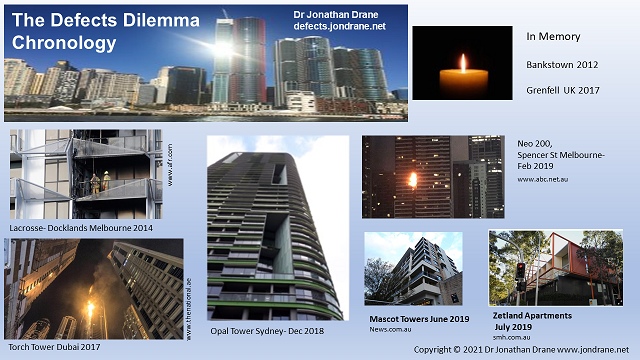How does the property developer fit into the revisionist Design and Build Act? Does it really solve The Defects Dilemma and what else is needed? . Dr Jonathan Drane of Expert Triage gives a quick heads up for insurers, lawyers and practitioners.
The new design and building act is a purpose built legislation designed to deal specifically with ‘multi-apartment buildings’ and how they should be designed and constructed.
Up to now and over many decades the ‘apartment building above three stories high’ has been the subject of confused legislation that originated in the era of the Home Warranty Act which was designed to deal primarily with houses (dwellings) up to three levels (e.g. a house or a town house).
The original legislation required that a builder have a license to build such a dwelling and the sensitivity was related to homes being built by dodgy builders which basically fell down or posed a threat to the occupants or the builder heading south! Office buildings as a side note to this did not need to be built by a licensed builder (and this continues to this day).
The concept of ‘dwelling’ has however been stretched to its limits to now include high rise multi-apartment towers which originated in 1961 with the advent of strata title and with the Blues Point Tower in 1962.
The earlier red brick high rise towers of the 60s and 70s however had a unique quality to their construction which included the predominant use of brickwork and concrete in the facades. It also enjoyed a proud history in the trades who built these towers being from a migratory post war Mediterranean origin with high trade standards.
The use of ACP (Aluminium Composite Panels with inflammable inner filling) was to arrive in the decades after this and be limited predominantly to commercial office towers and industrial buildings where history buffs will remember the ubiquitous ‘Alucabond’.
Now we have high rise multi apartment towers with hundreds of people across 10, 20 or 30 stories (or more) which until the new legislations (2020-1) still officially required a licensed builder but were not the subject of the earlier home warranty insurance ethos.
Protections arose instead through the building contract with a defects liability period of approximately one year which allowed the builder off the hook thereafter leaving the material warranties in the finished building as the main point of recourse to the apartment owner.
This strange limbo state existed at the time of the various tragedies and misadventures of developers and builder in the likes of Opal Tower, Bankstown, Lacross Docklands, Spencer Street and others (see chronology gallery below).
The two key new legislations that have arisen are:
-Design and Building Practitioners Act 2020-1
-Residential Apartment Buildings (Compliance and Enforcement Powers) Act 2020-1
The first serves to control the regulated design and construction of multi-unit & multi-storey residential apartment buildings.
The second seeks to provide a compliance regime with a connection to a watch dog government department.
The appointment of a Building Commissioner has also occurred to step up the instigations of these new standards and provide a new regulatory and more penal regime.
How does the Design and Building Practitioners Act shape up?
It is strange reading this legislation because it reads like a traditional construction delivery system i.e. the situation where the architect created the design and the builder built the building in accordance with the design. In this traditional system the quality of the building was to the Building Code of Australia and the quality also determined by the professional code of the architect.
Originally a council certifier and a clerk of works policed the construction with a self certifying quality to the system.
The new act describes the same players with different role names:
The ‘registered design practitioner’ creates ‘regulated designs’.
The registered builder who builds the building based on the ‘regulated design’.
The ‘principal design practitioner’ who ‘coordinates regulated designs’
The Building Code of Australia as a quality control for the above.
Less focus is made of the often corrupted political structure of Design and Construct contracting where the architect is commissioned by the builder thus subordinating the quality outcomes to the builder’s budget and ethics. This dynamic is at the heart of many of the case examples of defective buildings of a dire nature (see gallery).
No mention is made of the client or in the case of multi-apartment towers; The Property Developer and their modus operandi from running projects through sacrificial project vehicles, novating the architect to the design and construct builder and then washing their hands of any liability.
Recent accounts suggest that the D&C build system is the more common approach now and so the new legislations mirror this well and restore some of the solid foundations principles of the earlier ‘build only to a design’ approach.
The developer however remains on the outside looking in to this new legislation and so perhaps the next frontier of legislation involves concentrating on this connector. At the moment a developer bond is one solution but how effective will it be.
Read more on such developer behaviours in our other blog articles and on The Defects Dilemma.


Dr Jonathan Drane
5 August 2021


